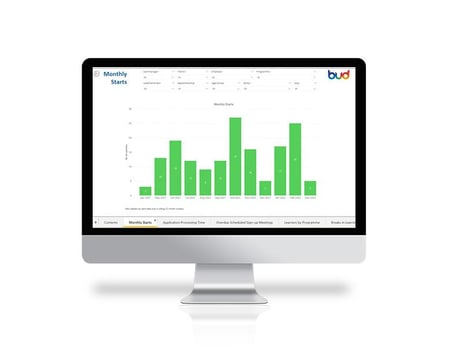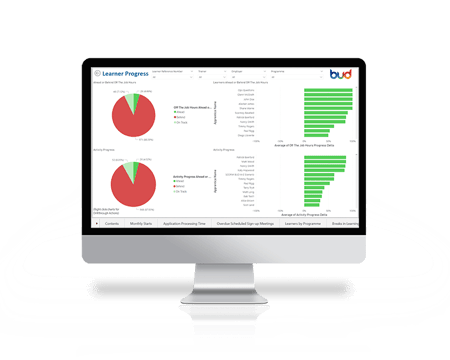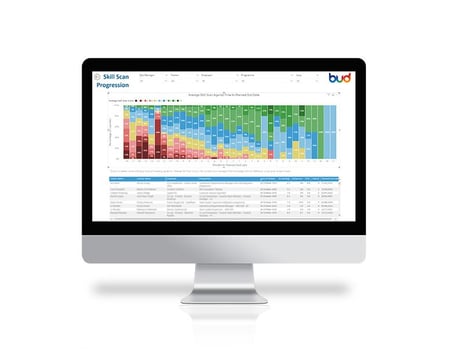How Bud is combining over 30 years of expertise with talent in software development to provide multiple benefits to training delivery.
Using data to support your Ofsted inspection
Having recently undergone a full inspection at The Learning Enterprise, Sarah Van Der Merwe shares how she utilised the data within Bud to provide Ofsted inspectors with the evidence they required.
Introduction
As we know all apprenticeship providers produce data daily. We use it for all sorts of reasons, to measure and track performance but it also provides us with information we need to understand our programmes and curriculum in more detail. What’s working and what isn’t. Where do we need to review and make improvements to help our learners and our teams?
In preparing for our imminent OFSTED inspection in 2021, we really considered how to use our data to demonstrate how we deliver high-quality training and effective experiences for our learners, managers and employers.
I had a progression and achievement data meeting to look at our qualification achievement rates, progression rates per programme, success and pass results. I was easily able to pull this from the data warehouse in Bud and present clear accurate visuals.
SARAH VAN DER MERWE, HEAD OF APPRENTICESHIPS AT THE LEARNING ENTERPRISE
Preparing the data
 We got ‘the call’ early October and having live data at my fingertips the moment I received that call meant I was confident to share up to date in year enrolment data, learner progress, programme numbers, employer names and postcodes, those who were on a break in learning, those who we are claiming additional learning support etc. Having the data fields pre-set in a Power BI report, that was ready to be exported for my planning call only an hour after the initial notification, was key. As all of our data is collected in a single platform I was confident that it was validated. The ILR is integrated and matches the exact data the inspector had gained from the ESFA. Being clear and accurate with our data helped the inspectorate team define the deep dive areas to focus on and the conversations we then went on to have at our planning meeting.
We got ‘the call’ early October and having live data at my fingertips the moment I received that call meant I was confident to share up to date in year enrolment data, learner progress, programme numbers, employer names and postcodes, those who were on a break in learning, those who we are claiming additional learning support etc. Having the data fields pre-set in a Power BI report, that was ready to be exported for my planning call only an hour after the initial notification, was key. As all of our data is collected in a single platform I was confident that it was validated. The ILR is integrated and matches the exact data the inspector had gained from the ESFA. Being clear and accurate with our data helped the inspectorate team define the deep dive areas to focus on and the conversations we then went on to have at our planning meeting.
Sharing the data
 The data also allowed me to prepare for the key meetings that I would have with the lead inspector. For example, following our intent meeting, I had a progression and achievement data meeting to look at our qualification achievement rates, progression rates per programme, success and pass results. I was easily able to pull this from the data warehouse in Bud and present clear accurate visuals.
The data also allowed me to prepare for the key meetings that I would have with the lead inspector. For example, following our intent meeting, I had a progression and achievement data meeting to look at our qualification achievement rates, progression rates per programme, success and pass results. I was easily able to pull this from the data warehouse in Bud and present clear accurate visuals.
One of the features The Learning Enterprise makes use of is the RAG rating status, allowing us to view who is on track, who is behind, who our high-risk learners are etc. Strategies for considering additional resources of support are then considered. The lead inspector particularly liked the fact I could track exactly when the RAG status had been updated showing accuracy and timely information from the team.
Navigating Bud
 Following our intention meeting I conducted a 10 min navigation and overview of Bud and gave each of the inspectors access to learners’ portfolios. This allowed me to show them our enrolment process, commitment statements, record of OTJ hours and where to find an action plan if a learner has gone off track. At the time of inspection, due to Covid pressures, a few of our learners were behind.
Following our intention meeting I conducted a 10 min navigation and overview of Bud and gave each of the inspectors access to learners’ portfolios. This allowed me to show them our enrolment process, commitment statements, record of OTJ hours and where to find an action plan if a learner has gone off track. At the time of inspection, due to Covid pressures, a few of our learners were behind.
Inspectors could see a learner’s starting point as the skills scan is integrated into the enrolment process, all of them told me they found this useful. It gave them time to triangulate their evidence over the 3 days. Having this access also allowed them to conduct the joint work scrutiny meetings they had with our programme leads and to have information to hand during their on-site learner meetings.
By using Bud trainers and assessors were also able to demonstrate how they manage their caseload by using the live metrics of their dashboard and within the caseload reviews, this was again triangulated in joint work scrutiny meetings and the progression and achievement meeting.
By using Bud trainers and assessors were also able to demonstrate how they manage their caseload by using the live metrics of their dashboard and within the caseload reviews.
SARAH VAN DER MERWE, HEAD OF APPRENTICESHIPS AT THE LEARNING ENTERPRISE
The Handbook
Whilst judgements aren’t made on data alone, it did provide inspectors with evidence to judge the impact of our quality of education.
Page 24, Paragraph 95 of the Inspection Handbook:
- Inspection uses a range of data that is available. Both before and during the inspection, inspectors will analyse the performance of the provider using the most recent validated data.
- Analysis may be at overall provider level and/or for individual subjects or types of provision.
- Although data alone will not lead directly to judgements, the primary data that measures success for each type of provision will provide important evidence for judging the impact of the quality of education.
The result
Apprentices benefit significantly from a carefully planned and challenging curriculum that reflects their individual needs and starting points. OFSTED Report
In February 2022, TLE were awarded Ofsted Outstanding.
How Bud can support you with Ofsted
Book a software demo and chat with a friendly Bud expert to find out why more of the Top 20 Independent Training Providers choose Bud than any other platform.




